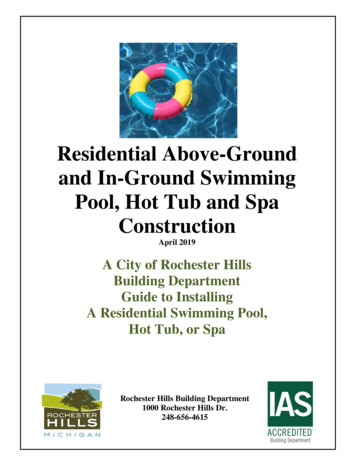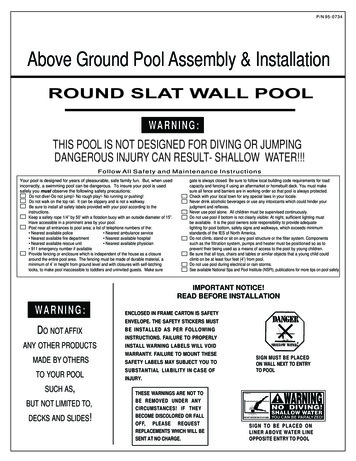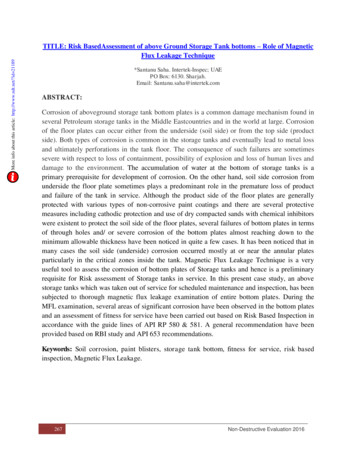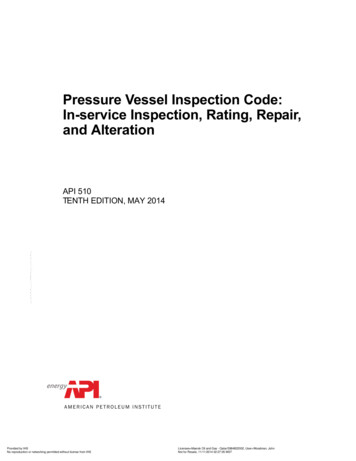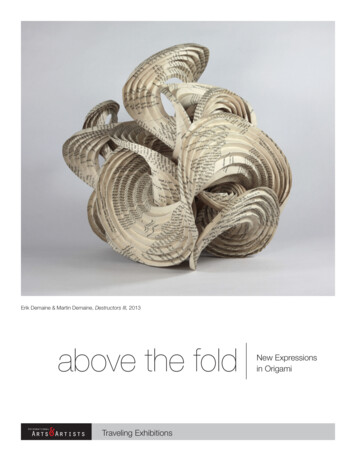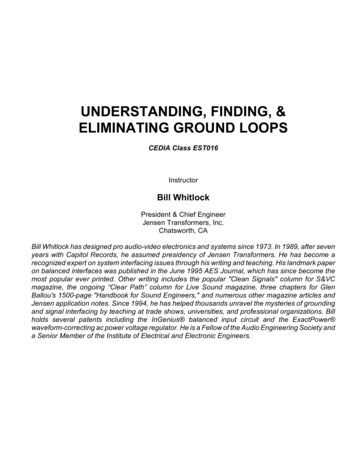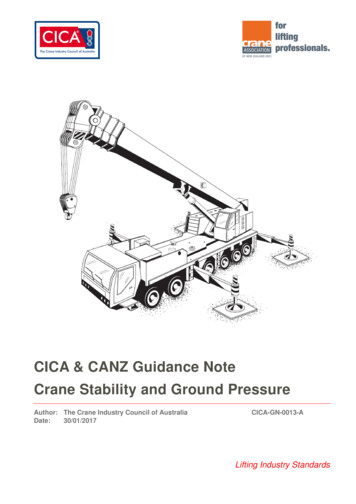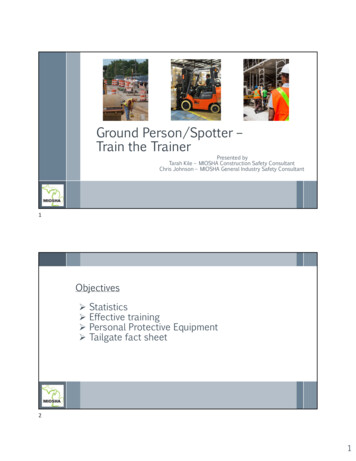
Transcription
WEFTEC .06INTEGRITY INSPECTION OF ABOVE GROUND STORAGE TANKSFrank Maitland, PEQUENSE LLC136 Edgemere AvenueWest Hartford, CT 06110860-232-8505ABSTRACT40 CFR 112.7 requires integrity inspection of containers subject to this regulation. Whereapplicable, inspection to a nationally recognized standard is required. Where there is nostandard, good engineering judgment is allowed. This paper discusses commonly used nationalstandards for inspection and methods of implementing common and less common inspectionstrategies. It gives owner/operators information on the required inspections to enable them toknow what type of inspection is available or required. It is not intended to give completeinstructions on how to conduct the required inspections.KEY WORDSIntegrity inspection, American Petroleum Institute (API), Steel Tank Institute (STI), MagneticFlux Leakage (MFL), Ultrasonic Testing (UT), National Fire Protection Association (NFPA).WHAT IS AN INTEGRITY INSPECTIONAn integrity inspection of a container(s) is a system designed to be sure that acontainer would not fail under normal operating conditions. In this application, itgenerally consists of three sections; frequent recorded visual inspections, lessfrequent rigorous external inspections and frequently, an internal inspection.WHO PERFORMS INTEGRITY INSPECTIONS?There are three groups of people involved in performing inspections. They are owner/operatorpersonnel; STI certified inspectors and/or API authorized inspectors. In general, owner/operatorpersonnel perform monthly, quarterly, annual and some longer-term inspections as required bythe SPCC plan or the chosen national standard. They must be knowledgeable about tanks andthe products stored in the tanks. STI certified inspectors perform longer-term inspections usingSTI criteria. API authorized inspectors do longer-term inspections under both API and STIcriteria. Both API and STI inspectors require specialized training and passing a test to gain theircertification. API and STI inspectors can be employees of the owner/operator who are dulytrained and certified, unless non-employee status is required by the regulatory jurisdiction. Theuse of these groups of people will become more obvious further in the paper.Copyright 2006 Water Environment Foundation. All Rights Reserved88
WEFTEC .06SMALLER UNITS; PINTS, QUARTS, GALLONS, PAILS, KEGSAll items less than 55 gallons do not require integrity testing, regardless of the number ofcontainers.Some examples of smaller packaged petroleum items that do not require integrity inspection.55-GALLON DRUMSThere is no nationally recognized standard for integrity testing of this size and style of container.In this area good engineering judgment is allowed. One method that is used is to be sure toinclude storage and use areas for these containers in a visual inspection plan. Depending uponthe number of drums and their area density, they could be included in the monthly-recordedinspections required under STI or API inspection requirements. If there is a main storagelocation for drums, maybe a daily or weekly sign-in sheet that someone checked the location tobe sure that there are no leaking drums. The design of the plan should also take into accountitems such as containment capabilities. Better containment may mean less frequent recordedinspections. Single drums being used in a given location could sit on a containment skid. It hasbeen successfully argued that a single drum rupture inside a properly sized facility with no floordrains cannot reach any location to do environmental damage. This does require adequate,readily available spill clean-up capabilities.These are the smallest containers that require anintegrity inspection under SPCC regulations.Copyright 2006 Water Environment Foundation. All Rights Reserved89
WEFTEC .06UL-80 TAMKS, 275, 330, 550, 660 GALLONSThese tanks are usually recognized as home heating oil style tanks. However, they do find usesin industrial applications. Prior to the latest version of SP001-05, some plans were written thatassigned a life to the tank, usually 20 years. The plans were written so that the tank would bereplaced at the end of the assigned life. This was usually cheaper than having the tanks inspectedby a certified inspector every 5 years. This method of handling the required tank integrity issuehas changed with the issuance of the latest SP001-05 standard.Yes, thesetanks are seenin industrialservice!UL-142 TANKS, NON-DOT TOTES; STI INSPECTIONSThese are the most common storage tanks in use today. They are tanks that are fabricated by atank manufacturer and are delivered complete to your site, usually by truck. Complete does notinclude appurtenances like valves, gauging systems, vents, etc. This includes horizontal andvertical tanks, single and double wall. Tanks supported on legs are also included. Totes not usedin commence also require inspection and can be done under this protocol. (Totes used incommerce require inspection to DOT specifications.)These totes and tanks can be inspected using SP001The Steel Tank Institute (STI) has created a tank inspection standard that is recognizednationally. It is recognized by EPA as a legitimate integrity inspection protocol. The standard isCopyright 2006 Water Environment Foundation. All Rights Reserved90
WEFTEC .06known as SP001-05. The –05 on the end denotes the year of issuance of the latest standard. Bythe time that this paper is presented, there may be a newer standard –06. The current –05 andproposed –06 are new protocols that substantially change the methodology for inspecting thesetanks. Ordinarily, standards do not change on a yearly basis, but the –05 was a new protocol andthe -06 is being issued to improve some minor issues. If you began an integrity inspectionprogram prior to the beginning of the new SPCC plans, it may be worth your time to update theprogram to the newer STI standard.The STI standard divides tanks inspected under the standard in to several categories.The categories include sizes and styles. Sizes include 0-1,100 gallons, 1,001 to 5,000 gallons,5,001 to 30,000 gallons and over 30,000 gallons. Styles include tanks supported off the floor,vertical and horizontal, tanks with Release Prevention Barriers and tanks with Leak Detection.The use of this standard also demands a commitment to follow not only major inspections, but toalso perform the owner/operator monthly, quarterly and annual inspections as required by thestandard. Depending upon the size and configuration of the tank, this may also include 5, 10 and20-year inspections. As you will see when you look at the standard, some tanks never require aninspection by a certified inspector. If you have a tank problem under these circumstances, andyour records are not up-to-date, you will be operating in violation of your SPCC plan.There is one exception to the shop built tank applicability stated above. Field erected tanks up to30’ in diameter can be inspected using the STI standard. There is a special section of the STIstandard dealing with this type of inspection.This 30’Ø tank can be inspected using SP001.Copyright 2006 Water Environment Foundation. All Rights Reserved91
WEFTEC .06Tanks on saddles or legs where the bottom is accessible can be entirely inspected from theoutside of the tank using ultrasonic testing (UT). This is completely legal. However,experienced inspectors know that tanks generally fail by pitting. It is very rare and to find a pitwith UT inspection. It is also generally recognized that UL-142 tanks do not fail catastrophicallyand that the regular inspections required by this standard should find leaks before they becomeserious. Tanks that are on saddles or legs that require an inspection to meet SPCC regulationscan be inspected by the external visual and UT method. If there is a question about the truecondition of a tank, ex. a sale or purchase or a long time in-service, an internal inspection shouldbe performed.SP001 offers an alternative inspection for leak integrity. It is a pressure test of the tank. Thestandard carefully states that the tank must be thoroughly cleaned prior to the pressure test andthat compressed air should not be used to test tanks that have been in service. This is a safetyrequirement.Tanks on legs, concrete encased tanks and double walled tanks are inspected using SP001.The general concept behind the STI inspection intervals is one of risk management. From thechart in the SP001 standard, it will be seen that the smaller a tank is, the less frequently or lessrigorous is the inspection. Also, the more safeguards that the tank has for pollution prevention,the less frequent and less rigorous is the inspection. This is because the smaller the potentialspill and the more anti-pollution precautions that have been taken, the less likely is a serious,uncontrolled spill. This is why the SPCC regulations exist.WHAT TO EXPECT FROM A STI TANK INSPECTION?The SP001 has forms that can be used for the monthly and annual owner/operator inspections.Using these forms as a base, a company can make their own forms. Some companies put theirforms on a PDA (Palm, Blackberry, Sony, etc). After completion, they are downloaded onto acomputer for long-term storage. Owner /operator inspections are required to be kept for 3 years.Inspectors providing formal external and/or formal internal inspections should issue a report thatincludes the checklists required by SP001, any data, any analysis of data and required orrecommended repairs. Required repairs are those required by the standard or those that willCopyright 2006 Water Environment Foundation. All Rights Reserved92
WEFTEC .06affect the structural integrity of the tank until the time that the next similar inspection is required.Also, relevant drawings and pictures are often included. Inspections performed by API or STIcertified inspectors are required to be kept for the life of the tank.FIELD FABRICATED TANKS, API-653 INSPECTIONSField fabricated tanks are tanks that were delivered to the worksite in pieces, usually flat orrolled. Some minor pieces may be assembled such as manholes or nozzles. The tanks areusually built to American Petroleum Institute (API) standards. Older tanks may have not beenconstructed to a particular standard, but they can be inspected using the API-653 inspectionstandard.This riveted tank and larger welded tanks are inspected using API-653.API-653 is the standard by which these tanks are inspected. As with the STI standard,owner/operator inspections are required along with inspections by an Authorized Inspector. Thestandard is much larger and more comprehensive than the STI standard. The tanks covered bythe standard are larger and present larger risks than the tanks covered by the STI standard. Priorto the advent of the STI standard in 2000, all steel aboveground tanks were inspected using theAPI-653 standard.API-653 standard requires routine, In-service and Out-of-service inspections. A routineinspection is a monthly recorded inspection by the owner/operator. An In-service inspection isCopyright 2006 Water Environment Foundation. All Rights Reserved93
WEFTEC .06an inspection by an Authorized Inspector of the outside of the tank while the tank remains inservice. This usually includes a thorough visual inspection of the tank along with ultrasonictesting (UT) and level measurements. These inspections are required every five years or less,depending upon inspection findings.Out-of-Service inspection involves emptying and cleaning the tank so that it can be inspectedinternally. In general, Out-of-Service inspections are required at a maximum time interval of 20years. However, it is also required that the corrosion rate of the floor be determined within tenyears of the floor installation. This frequently involves the cleaning of the tank for an internalinspection to determine the corrosion rate. When the corrosion rate is known and requiredrepairs are completed, the next Out-of-Service time interval is calculated.When the tank is emptied and cleaned, the amount of corrosion is partially determined bymeasuring the depth of pits on the floor topside. Floors also corrode from the underside. Thereare several methods of determining the depth of underside pitting. The most popular method isMagnetic Flux Leakage (MFL) testing with UT follow-up. This method allows the floor to bescanned (up to 97% of the floor can be covered). Areas indicating a problem are furtherinspected using UT methods. It is widely agreed that tank floors fail mostly by pitting. Thismethod helps to find significant under floor pitting. Combining the floor topside and undersidecorrosion rates gives the corrosion rate, which is then used to determine the next inspectioninterval as mentioned above.One type of MFL machine for floor scanning. Note: Internal floating roof.There are other methods of determining floor corrosion rates. Statistical analysis of randomfloor thickness readings is sometimes used. The random numbers can be gotten after the tank iscleaned. There is a method that places a robot into the tank and gets the random UT readingswhile the tank is in-service. Eddy current testing is another floor inspection method that isbecoming more popular.WHAT TO EXPECT FROM AN API-653 TANK INSPECTION?API-653 requires the authorized inspector to be on-site for the inspection to qualify as an APIinspection. This is not necessarily at the same time as the data is gathered. The API inspection ismore rigorous because the structures are larger and more things can and do go wrong. Theinspection report is usually larger and in more detail than the STI report. It usually includes anCopyright 2006 Water Environment Foundation. All Rights Reserved94
WEFTEC .06inspection narrative with required and recommended repairs; the API-653 checklist; calculationsand data including UT data, level survey and analysis, results of magnetic particle testing, ifnecessary, MFL report, floor thickn
constructed to a particular standard, but they can be inspected using the API-653 inspection standard. This riveted tank and larger welded tanks are inspected using API-653. API-653 is the standard by which these tanks are inspected. As with the STI standard, owner/operator inspections are required along with inspections by an Authorized Inspector. The standard is much larger and more .
